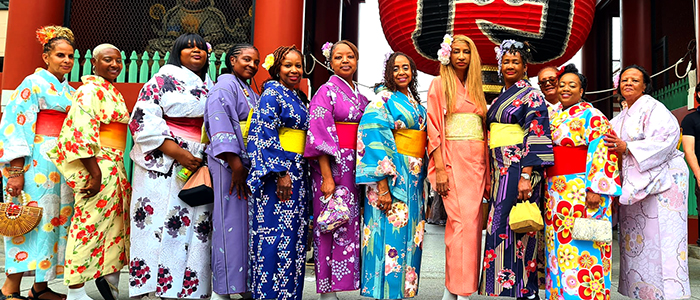
Less Can Be More
 |
Hi Family,
Our 2025 ladies have just returned from their incredible journey in Japan. May have messaged that a part of them still lingers. Japan doesn’t leave you all at once; it stays in your heart, your posture, the quiet way you begin to notice things again. Its peaceful rhythm felt like a long, steady exhale, a calm contrast to the uncertainty that so often surrounds life back home.
At Globalnista, our journeys have never been about simply seeing the world; they’re about feeling it. We travel to listen, to learn, and to be changed by the cultures that embrace us. Our experiences aren’t measured by five-star hotel ratings or square footage, but by the moments that move us, the intangibles that can’t be priced because they touch the spirit. Our Japan journey was no different.
From the modern hum of Tokyo to Kyoto’s gentle peacefulness and Osaka’s spirited charm, Japan revealed a new rhythm of grace. It doesn’t simply invite you to visit; it teaches you how to be, how beauty can live in order, intention, and restraint.
One of our most meaningful moments was exploring the geisha tradition and the artistry of the kimono. We learned that every layer of the kimono carries meaning: respect, modesty, and centuries of storytelling stitched into silk. The garments are not costumes but cultural expressions, symbols of identity and discipline.
Beneath the outer kimono lies the nagajuban, whose slightly raised collar, our instructor explained, is meant to remind the wearer to carry herself with quiet grace. Whether or not that is an old rule, it certainly felt true. As we dressed, our movements softened, our postures lengthened, and we began to embody the gracefulness the kimono was designed to inspire. You can wear a kimono anywhere in the world, but there is something about wearing one in Japan that is transformative. You fell the culture.
Then came the shoes, the geta and zori sandals. Our first steps were awkward and a bit scary; some of us were even concerned about falling. But slowly, without even noticing, we began to find our rhythm. In time, those careful steps turned into graceful movement. There was a newfound elegance in the way everyone walked and carried themselves. The slower pace wasn’t just about balance; it was about presence. It was as if the shoes themselves were teaching us to move through life more intentionally, one thoughtful step at a time.
It was a gentle lesson in how environment shapes energy. Just as the kimono influences posture, Japan itself encourages presence. The more time you spend there, the more you find yourself adapting, sitting taller, walking slower, speaking softer. It’s a beautiful reminder that we are, in many ways, reflections of what surrounds us.
When we immerse ourselves in places of calm and respect, we begin to mirror that energy. But the reverse is also true. Whether in our travels or in our own neighborhoods, we are just as easily shaped by gossip, negativity, chaos, or impatience. Japan reminded me how profoundly we are influenced, for better or for worse, by the people and environments we choose to let into our orbit. The gift of travel is that it lets us see this contrast clearly and choose, with intention, the kind of energy we wish to carry home. Travel has taught me to be more open-minded and less judgemental. Everyone can look at the same tree and see something different. There is beauty in the sturdy roots and in the leaves that flutter in the wind, both have importance.
This awareness is also why we’ve always been intentional about the women who travel with us. We know it affects how many people join our journeys; we could be much larger if we welcomed anyone willing to pay. But for me, the beauty of Globalnista lies in balance, not scale. Each group is like a composition, every woman a distinct note contributing to the harmony of the whole. When that harmony is right, the journey moves with ease and grace. So, we choose with care. Not by perfection or sameness, but by spirit, women who understand that travel, like life, becomes most meaningful when we move in rhythm with one another, each step becoming a positive collective flow.
That same spirit of harmony is reflected throughout Japan itself. The sense of quiet discipline that shapes daily life here feels both familiar and affirming. It’s in the spotless subway stations, in restaurants where even the kitchens gleam, and on streets so clean they seem to shimmer. What struck me most was that this wasn’t just for show. Cleanliness in Japan is an act of respect, a silent agreement that the spaces we share should mirror the harmony we seek. I’ve only seen such devotion to order in Singapore, yet here it feels softer, almost meditative.
Even in the way the Japanese dress, that same harmony is visible. Most people move through the day in blacks, whites, shades of gray and muted neutrals that seem to blend into the landscape rather than compete for attention. Yet there’s nothing dull about it. The beauty lives in the details,: the texture of a fine fabric, the way a sleeve drapes, a precise fold that catches light just so. It’s fashion without noise, confident but quiet, refined but never showy. I found it fascinating, even freeing.
There was no pressure to stand out or perform; you could simply exist within the rhythm of the city. There’s a kind of peace in that, in being part of the whole rather than always trying to be seen. It reminded me again of Japan’s deep respect for age and things that endure: fabrics, traditions, even ways of being, and people themselves, all age gracefully, not fade with the season.
And then there are the people, kind, attentive, and always aware. More than once, someone paused to offer gentle help, not with intrusion but with grace. In a world where so much feels uncertain, there was comfort in this quiet dependability. Structure, here, doesn’t confine; it holds. It reminds you that safety, courtesy, and care can still be a way of life. It made me realize that perhaps this is why now, more than ever, we need to experience places like Japan, where calm still exists and order feels like an embrace.
And yes, even the smallest details seem designed with care. Like the warm toilet seats, which may sound trivial until you’ve experienced one on a chilly morning. It’s such a simple thing, yet it captures what Japan does best: anticipating comfort before you even think to ask for it.
And this is why I’ve decided to take an extended personal journey through Japanese culture, to learn more deeply what makes this society so quietly remarkable. I’ve begun studying Ikigai, the Japanese philosophy of finding purpose, and Kintsugi, the art of golden repair, both lessons in how beauty and balance can emerge from imperfection. I’m also exploring Japan’s deep love for the vintage, where age is not something to discard but to celebrate. In Japan, a worn teacup, a faded kimono, or a scuffed handbag holds its own quiet prestige because it carries history. It’s a reflection of a society that honors endurance and sees beauty not in what is new, but in what has lived.
These experiences reminded us that travel is not only about seeing, but about becoming. About absorbing lessons that live in the smallest gestures, a bow, a polished floor, a carefully folded sleeve.
When we return for Japan 2026, it won’t just be a trip through landscapes, but through philosophies, an exploration of the artistry behind how the Japanese live, move, and care for what surrounds them.
Thank you for being part of this Globalnista family, travelers who understand that true luxury lies not in what we consume, but in what we learn and carry home within us.
With love and reflection,
Fleace
Founder, Globalnista
Fleace
Founder, Globalnista
Experience Japan with us in 2026
Highlights from 2025 I Details 2026
Highlights from 2025 I Details 2026
The richest journeys are about people, not things.
Globalnista
323.275.4888
www.Globalnista.com